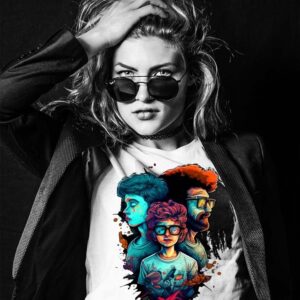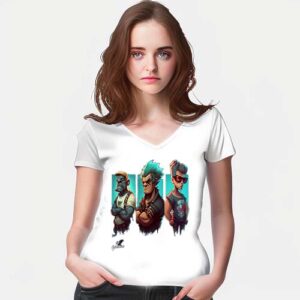





























Graphic printed tees have become a famous fashion statement. People are looking for unique and eye-catching designs that allow them to express their personality and style. Artificial intelligence (AI) has entered the fashion world with technological advancements, specifically in creating t-shirt designs. AI-generated t-shirt designs are gaining recognition as a form of art. This article explores the artistry behind AI-generated t-shirt designs and their impact on the fashion industry.
The Rise of AI-Generated T-Shirt Designs
AI-generated t-shirt designs have revolutionized the way we approach fashion. These designs are created using algorithms and machine learning techniques, allowing AI to analyze patterns, colors, and aesthetics. The AI software can generate unique and visually appealing t-shirt designs that capture attention and spark creativity.
The Role of AI in Fashion
AI has made significant advancements in various industries, and the fashion industry is no exception. With the ability to analyze vast amounts of data and patterns, AI can help designers create innovative and personalized t-shirt designs. AI algorithms can generate plans based on user preferences, historical fashion trends, and cultural influences.
The Creative Process of AI-Generated Designs
The creative process of AI-generated designs begins with training the AI model. The model is fed with a large dataset of existing t-shirt designs, allowing it to learn patterns, styles, and color combinations. Once trained, the model can generate new designs based on the known ways. Designers can then refine and customize these generated designs to create unique t-shirt designs that resonate with their brand and target audience.
The Artistry Behind AI-Generated T-Shirt Designs
AI-generated t-shirt designs are more than just lines of code and algorithms. They embody the artistry and creativity of AI software and the human designers who refine the generated methods. The combination of AI’s ability to analyze vast amounts of data and the human touch of refining and adding personal flair creates a unique art form.
Blending Tradition with Innovation
AI-generated t-shirt designs bridge the gap between traditional design techniques and cutting-edge technology. The AI algorithms can analyze historical design trends and incorporate them into modern designs, creating a fusion of tradition and innovation. This blend allows designers to create t-shirt designs that are timeless and contemporary.
Pushing the Boundaries of Creativity
AI-generated t-shirt designs push the boundaries of human creativity. The algorithms can explore unconventional color palettes, intricate patterns, and abstract designs that might have yet to be considered by human designers. This opens new possibilities for artistic expression and allows designers to create unique and captivating t-shirt designs.
Inspiring Collaboration
AI-generated t-shirt designs also foster collaboration between AI software and human designers. The AI software is a creative partner, providing suggestions and generating design options that designers can build upon. This collaboration sparks creativity and allows designers to explore new design ideas they might have yet to consider independently.
The Impact of AI-Generated T-Shirt Designs on the Fashion Industry
AI-generated t-shirt designs have had a significant impact on the fashion industry. They bring a fresh perspective to the design process and offer new opportunities for designers and consumers.
Increased Efficiency in the Design Process
AI in t-shirt design streamlines the creative process and increases efficiency. AI algorithms can generate multiple design options in a short amount of time, saving designers hours of work. This allows designers to focus on refining and perfecting the generated designs, resulting in high-quality t-shirt designs in less time.
Personalized and Customizable Designs
AI-generated t-shirt designs have made personalized and customizable designs more accessible. Designers can use AI algorithms to generate plans based on customer preferences and feedback. This level of personalization allows designers to create t-shirts that resonate with their target audience, leading to increased customer satisfaction and brand loyalty.
Exploration of New Design Aesthetics
AI-generated t-shirt designs encourage designers to explore new aesthetics and experiment with unconventional styles. The algorithms can analyze emerging fashion trends and cultural influences, inspiring designers to create designs ahead of the curve. This exploration of new design aesthetics keeps the fashion industry fresh and exciting.
The Future of AI-Generated T-Shirt Designs
The future of AI-generated t-shirt designs is promising. As AI continues to evolve and improve, we can expect even more innovative and visually stunning designs in the fashion industry.
Enhanced Personalization
With advancements in AI, t-shirt designs can become even more personalized. AI algorithms can analyze individual preferences, style choices, and even body measurements to generate t-shirt designs that perfectly fit each customer. This personalization level will revolutionize how we shop for t-shirts and enhance the overall customer experience.
Sustainability and Ethical Considerations
AI-generated t-shirt designs also have the potential to address sustainability and ethical concerns in the fashion industry. AI algorithms can generate strategies that promote eco-friendly fashion by analyzing data on sustainable materials. Additionally, AI can help designers optimize production processes, reducing waste and minimizing the environmental impact of t-shirt manufacturing.
Collaborative Design Platforms
The future of AI-generated t-shirt designs might involve collaborative design platforms where AI software and human designers work together in real-time. These platforms would allow designers to receive instant feedback and suggestions from AI algorithms, making the design process more interactive and efficient.
Conclusion
AI-generated t-shirt designs are a testament to the artistry and creativity that can arise from the collaboration between humans and technology. These designs push the boundaries of traditional fashion design and offer new possibilities for artistic expression. As AI continues to evolve, we can expect even more innovative and personalized t-shirt designs that revolutionize the fashion industry. Embracing AI-generated designs as a form of art opens up exciting opportunities for designers, consumers, and the future of fashion.
The Artistry of AI: Recognizing AI-Generated T-Shirt Designs as Art-Table
| Topic | Description |
| The Rise of AI-Generated Designs | AI’s impact on the fashion industry and the creation of t-shirt designs through algorithms and machine learning. |
| The Role of AI in Fashion | How AI is utilized in the fashion industry to analyze data, predict trends, and generate personalized designs. |
| The Creative Process | The steps involved in creating AI-generated t-shirt designs, from training the AI model to refining the generated methods. |
| The Artistry Behind AI-Generated Designs | The combination of AI algorithms and human designers’ creativity in creating unique and visually appealing t-shirt designs. |
| Blending Tradition with Innovation | The fusion of traditional design techniques and cutting-edge technology in AI-generated t-shirt designs. |
| Pushing the Boundaries of Creativity | How AI-generated designs explore unconventional color palettes, patterns, and abstract concepts, pushing the limits of human creativity. |
| Inspiring Collaboration | The collaboration between AI software and human designers sparking creativity and opens up new design possibilities. |
| The Impact on the Fashion Industry | The efficiency and personalization benefits of AI-generated t-shirt designs and the exploration of new design aesthetics. |
| The Future of AI-Generated Designs | The potential for enhanced personalization, sustainability considerations, and collaborative design platforms in the future. |
| Conclusion | The recognition of AI-generated t-shirt designs as art and the exciting opportunities they bring to the fashion industry. |